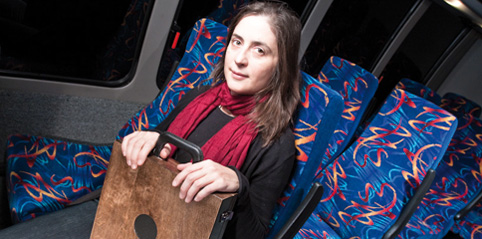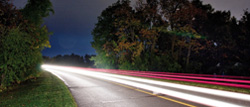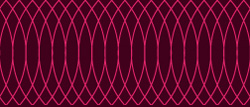

Marla Hlady’s practice as a sculptor and sound artist is rooted in a consideration of the relationship between sound, space, and social context. The work she created for Nite Ride thus began as an exploration of the spatio-temporal experience of night driving, which she then carried forward through the various stages, architectures, geographies, and social spaces of the project. Bypassing the 5.1 surround sound system on the bus, Hlady produced a set of eight portable sound objects—square boxes the size and shape of LPs, outfitted with briefcase handles and speakers, and finished with the high-gloss urethane of acoustic stringed instruments. Each box contained a unique sound loop, a fragment that Hlady had recorded by placing two shotgun microphones in the back seat of her car and then driving around Ottawa with the windows open. The result is a hypnotic mix of music from her car stereo, traffic noise, wind interference, and occasionally even birdsong. Passengers on the bus further modulated these loops via a mercury switch concealed within each box, which produced a sound effect similar to a skipping record.
During the Nite Ride bus tours, Hlady’s sound objects were distributed among passengers, who were encouraged to experiment with them by playing with their mercury switches, reconfiguring them throughout the space, and passing them back and forth, thus creating a living, moving sound puzzle. The Web version of the project functions as a kind of aural trace of these collective sonic experiments, which have, in a sense, traveled from one end of the project to other. In the spirit of this continuing voyage, Hlady has shifted the final emphasis from experimental sound to experimental geography, adding a set of chance-based driving instructions to the MP3 soundtrack. In this way, the audience will continue to reinvent the project on an individual basis.
![]()
Marla Hlady is a Toronto-based artist who produces kinetic installations and sound works that are by turn contemplative, amusing and disquieting. The artist describes her studio practice as characterized by the play of content, form, functionality and material, where material signifies both what is heard and what is seen.
Although she is best known for her playful, interactive sculptures, which earned her a Sobey Art Award nomination in 2002, her work ranges from site-specific installations to sculpture, drawing and sound pieces. She received a BFA from the University of Victoria in 1987, and went on to complete an MFA at York University in 1990. Hlady gained prominence on the art scene in the early 1990s, and has exhibited extensively in Canada and abroad, at venues that include The Power Plant Gallery (Toronto), Zabriskie Gallery (New York), Klink and Bank (Reykjavik, Iceland), and The Nunnery (London, England). In 2005 she completed an invitational residency in Iceland, and in 2008 she launched Playing Piano, a solo touring exhibition organized by YYZ Artists Outlet (Toronto).
Marla Hlady is particularly adept at negotiating a balance between the visual and audio elements of her sound installations, and her aesthetic approach and inventiveness are well-suited to creative problem-solving and new forms of presentation. This was demonstrated in her recent project Playing Piano (YYZ Artist Outlet, 2007), which featured a stripped, altered and reconfigured a player piano that generated an unexpected and subversive auditory experience through the combined force of a microprocessor and vintage piano rolls.
Marla says she is interested in the “relationships between the work, the space it occupied, and all the multifarious possibilities inherent in a viewer (both a physical body and a social construction) interacting with the work in the space.” With their subverted functionality, and their limitless variations created by viewers, Marla’s artworks “are made of the things that would make John Cage proud.” (CHARLENE LAU , Canadian Art)



